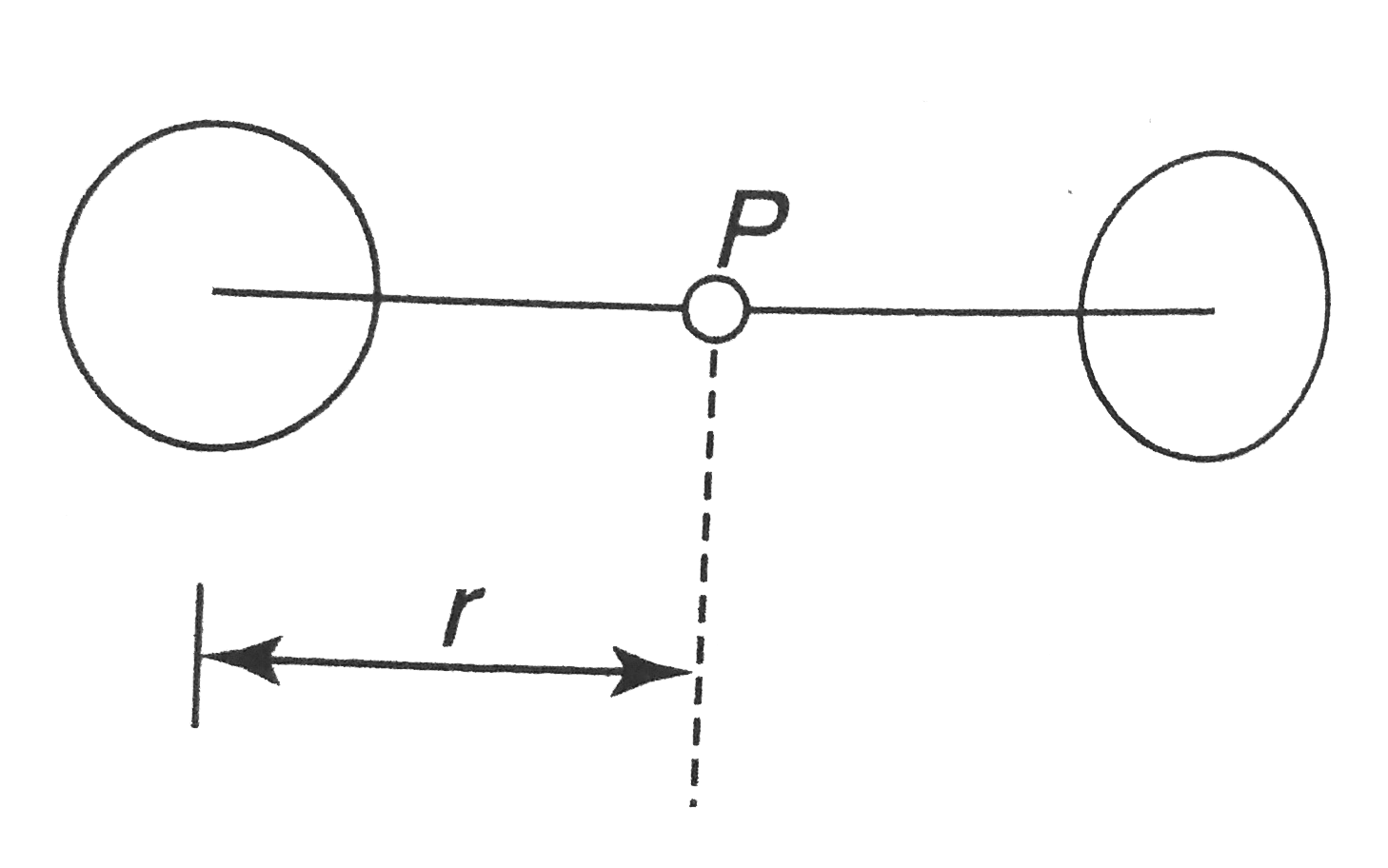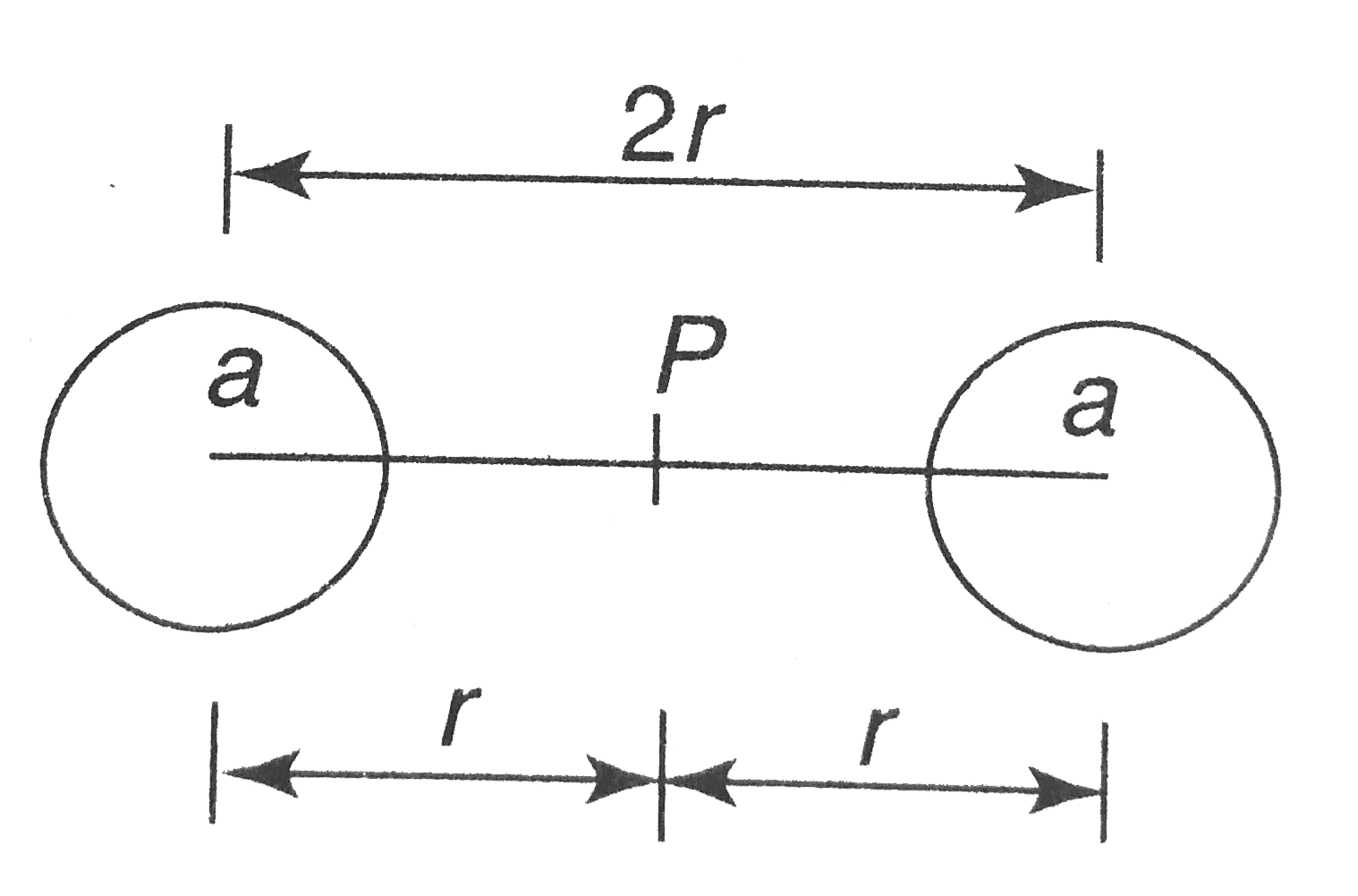If a particles of mass m is projected with minimum velocity form the surface of a star with kinetic energy K1GMma and potential energy at surface of the star K2GMma towards the star of same mass m and radius a (K1 and K2 are constant) to reach the other star. Find the distance between the centre of the two stars:
2a(K2−K1)
4a(K2−K1)
2a(K1−K2)
a(K1−K2)
The correct Answer is:B
Since the mass and radius of two stars are same, point P at which gravitational force will be equal, will be at equal distance (say r) from centre of each star. The particle should be projected to cross P, beyond which the particle will be attracted towards the other star.
KE=PE of body at P -PE at surface of the star
K1GMma=[−GMmr−GMmr]−[−K2GMma]
On solving, r=2a(K2−K1)2r=4a(K2−K1)

Topper's Solved these Questions
- GRAVITATIONBOOK - A2ZCHAPTER - GRAVITATIONEXERCISE - Assertion Reasoning
16 Videos
- GRAVITATIONBOOK - A2ZCHAPTER - GRAVITATIONEXERCISE - NEET Questions
42 Videos
- GRAVITATIONBOOK - A2ZCHAPTER - GRAVITATIONEXERCISE - Motion Of Satellite
33 Videos
- GENERAL KINEMATICS AND MOTION IN ONE DIMENSIONBOOK - A2ZCHAPTER - GENERAL KINEMATICS AND MOTION IN ONE DIMENSIONEXERCISE - Chapter Test
30 Videos
- KINETIC THEORY OF GASES AND THERMODYNAMICSBOOK - A2ZCHAPTER - KINETIC THEORY OF GASES AND THERMODYNAMICSEXERCISE - Chapter Test
29 Videos
Similar Questions
A particle of mass 'm' is projected with a velocity v=kVe(k<1) from the surface of the earth.(Ve = escape velocity)The maximum height above the surface reached by the particle is:
View SolutionA particle is projected upward from the surface of the earth (radius R ) with a kinetic energy equal to half the minimum value needed for it to escape. If the height it rises above the surface of the earth is h=kR, then find k.
View Solution
Knowledge Check
A particle is projected from the surface of one star towards other star of same radius a and mass with such a minimum velocity K√GMa, so that it is attracted towards other star. Find the value of K if two stars are 2r distance apart:
 A2(r−a)[r(2r−a)]1/2B2(r−a)[r(r−a)]1/2Cr−a[r(r−a)]1/2Dr+a[r(r−a)]1/2
A2(r−a)[r(2r−a)]1/2B2(r−a)[r(r−a)]1/2Cr−a[r(r−a)]1/2Dr+a[r(r−a)]1/2Two stars bound together by gravity orbit othe because of their mutual attraction. Such a pair of stars is referred to as a binary star system. One type of binary system is that of a black hole and a companion star. The black hole is a star that has cullapsed on itself and is so missive that not even light rays can escape its gravitational pull therefore when describing the relative motion of a black hole and companion star, the motion of the black hole can be assumed negligible compared to that of the companion.
The orbit of the companion star is either elliptical with the black hole at one of the foci or circular with the black hole at the centre. The gravitational potential energy is given by U=−GmM/r where G is the universal gravitational constant, m is the mass of the companion star, M is the mass of the black hole, and r is the distance between the centre of the companion star and the centre of the black hole. Since the gravitational force is conservative. The companion star and the centre of the black hole, since the gravitational force is conservative the companion star's total mechanical energy is a constant. Because of the periodic nature of of orbit there is a simple relation between the average kinetic energy <K> of the companion star Two special points along the orbit are single out by astronomers. Parigee isthe point at which the companion star is closest to the black hole, and apogee is the point at which is the farthest from the black hole.
Q. For circular orbits the potential energy of the companion star is constant throughout the orbit. if the radius of the orbit doubles, what is the new value of the velocity of the companion star?Ait is 1/2 of the old valueBit is 1/√2 of the old valueCit is the same as old valueDit is double the old valueTwo stars bound together by gravity orbit othe because of their mutual attraction. Such a pair of stars is referred to as a binary star system. One type of binary system is that of a black hole and a companion star. The black hole is a star that has cullapsed on itself and is so missive that not even light rays can escape its gravitational pull therefore when describing the relative motion of a black hole and companion star, the motion of the black hole can be assumed negligible compared to that of the companion.
The orbit of the companion star is either elliptical with the black hole at one of the foci or circular with the black hole at the centre. The gravitational potential energy is given by U=−GmM/r where G is the universal gravitational constant, m is the mass of the companion star, M is the mass of the black hole, and r is the distance between the centre of the companion star and the centre of the black hole. Since the gravitational force is conservative. The companion star and the centre of the black hole, since the gravitational force is conservative the companion star's total mechanical energy is a constant. Because of the periodic nature of of orbit there is a simple relation between the average kinetic energy <K> of the companion star Two special points along the orbit are single out by astronomers. Parigee isthe point at which the companion star is closest to the black hole, and apogee is the point at which is the farthest from the black hole.
Q. Which of the following prevents the companion star from leaving its orbit and falling the black hole?AThe centripetal forceBthe gravitational forceCThe companion star's potential energyDThe companion star's kinetc energy
If a particle of mass 'm' is projected from a surface of bigger sphere of mass '16M' and radius '2a' then find out the minimum velocity of the particle such that the particle reaches the surface of the smaller sphere of mass M and radius 'a'. Given that the distance between the centres of two spheres is 10 a.
View Solution_S01_010_Q01.png)
A particle of mass m0 is projected from the surface of body (1) with initial velocity v0 towards the body (2). As shown in figure find the minimum value of v0 so that the particle reaches the surface of body (2). Radius of body (1) is R1 and mass of body (1) is M1. Radius body (2) is R2 and mass of the body (2) is M2 distance between te center the center of two bodies is D.
View SolutionIn a double star system, two stars of masses m1 and m2 separated by a distance x rotate about their centre of mass. Find the common angular velocity and Time period of revolution.
View SolutionA particle of mass 'm' describes circular path of radius 'r' such that its kinetic energy is given by K=as2. 's' is the distance travelled, 'a' is constant :
View SolutionTwo stars of masses m1 and m2 distance r apart, revolve about their centre of mass. The period of revolution is :
View Solution
